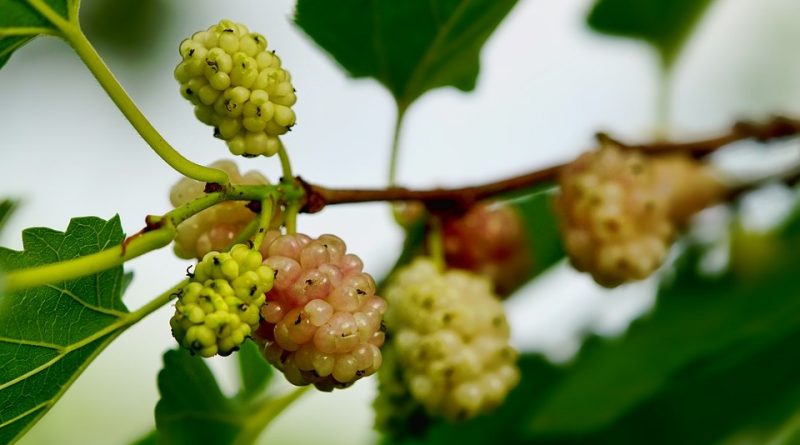Morus alba
Morus alba
The white mulberry (Morus alba L.) is a fruit tree belonging to the Moraceae family.
Systematics –
From the systematic point of view it belongs to the Domain Eukaryota, Kingdom Plantae, Magnoliophyta Division, Magnoliopsida Class, Order Urticales, Family Moraceae and therefore to the Genus Morus and to the Species M. alba.
Etymology –
The term Morus derives from the Latin name of the mulberry in Ovid and Pliny and from the Greek μορέα moréa. The specific dawn epithet for the white color referred to flowers, bark, fruits, etc.
Geographic Distribution and Habitat –
The Morus alba is a large tree (up to 15-20 m tall), which contains latex, native to northern China and Korea. It has been imported into Europe with the silkworm that is greedy of its leaves. This plant grows in sunny places or at most in the shade, and requires ample space as it reaches considerable size.
Description –
The white mulberry is a deciduous and broad-leaved tree, with a rather rapid growth, which can become secular, with an irregularly branched trunk, a dense, broad and rounded crown at the top. The bark is yellowish-gray and then becomes dark brownish-brown, deeply furrowed and chapped in more or less vertical fibrous bands forming small elongated scales. The wood is hard and resistant with a cribro-vascular change attached to the bark, and not to the sapwood. It emits a thick, milk-white latex and is irritating.
The leaves are deciduous, alternate, distichous, carried by a fluted petiole and adorned with small deciduous lateral stipules with dimensions ranging between 7-14 cm in length and 4-6 cm in width, with the upper lamina being shiny and smooth and lower scarcely tomentosa on the ribs. The flowers are unisexual and rarely hermaphrodite, with the male ones forming inflorescences with a cylindrical form and the female ones forming globular catkins. Usually the flowers of different sex are found in separate plants (dioiche) but the cases of specimens with both inflorescences on the same plant are not rare. The Morus alba has a flowering period between April and May.
The infructescence (blackberry) is an ovoid or rounded sorose of 1-2.5 cm, white or pink or violet, composed of an aggregate of monstrous fruit of 1.5-2 mm, with their fleshy perianzi (pseudo-drupe) , derived from an inflorescence and from its axis also become fleshy.
Cultivation –
The Morus alba has had an enormous diffusion until the half of the 20th century; subsequently, with the emergence of synthetic fibers, with the decrease of silkworm breeding, and with it also the white mulberry has disappeared.
For the cultivation technique of this plant consult the following card.
Uses and Traditions –
The Morus alba was introduced in Europe around the fifteenth century, basically for silkworm breeding, so much so that it is found sporadically as a result of old crops in southern Europe, especially in Italy and Spain, where the silkworm breeding was particularly widespread until the fifties . The importation is due to Italian monks returning from their journeys of evangelization in Asia, along with some silkworms.
In the nineteenth century in many Italian regions the mulberry tree had become a fundamental crop and this importance persisted until the 50s of the last century, due to the introduction of synthetic fibers and new fabrics.
Unfortunately, the decadence of silkworm breeding in the whole of Europe has led to decreased agricultural interest in this species. Currently it is used as an ornamental plant and for the joint use of its fruits.
However, its use as a fruit plant remains of little interest, even though numerous varieties have been selected for this purpose.
Some current uses of this plant are the use of wood for the construction of composite arches in Asia, for the production of traditional balsamic vinegar of Modena and for the construction of barrels that give a particular aroma to the product.
The mulberry wood also presents various molecules such as phytoalexins and high molecular weight organic compounds and is used as a reagent for the chemical detection of numerous cations.
Preparation Mode –
Fresh mulberry blackberries are consumed directly but are also excellent for making jams. In fresh consumption are also added to yogurt, ice cream, creams and someone uses them in addition to salads.
Once the fruits were considered laxatives. Moreover for the high content of sugars (22%) different Asian populations used them as sweeteners, both fresh and dried, reduced in flour.
Guido Bissanti
Sources
– Wikipedia, the free encyclopedia.
– Treben M., 2000. Health from the Pharmacy of the Lord, Advice and experience with medicinal herbs, Ennsthaler Publisher
– Pignatti S., 1982. Flora of Italy, Edagricole, Bologna.
– Conti F., Abbate G., Alessandrini A., Blasi C. (edited by), 2005. An annotated checklist of the Italian vascular flora, Palombi Editore.
Warning: Pharmaceutical applications and alimurgical uses are indicated for informational purposes only and do not in any way represent a medical prescription; there is therefore no liability for their use for curative, aesthetic or food purposes.


